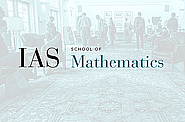Seminars
The Theoretical Computer Science and Discrete Mathematics Seminars will take place every Monday at 10:30 a.m. - 11:30 a.m. and every Tuesday at 10:30 a.m. - 12:30 p.m. at the Institute for Advanced Study. The lectures will be held in S-101, the seminar room in Simonyi Hall, unless stated otherwise.
If you are interested in attending future seminars and are not already on our mailing list from previous years, please send an e-mail to Andrea Lass and ask to be added.

Upcoming Seminar Titles Include:
Jan
20
2026
Jan
20
2026
Jan
26
2026
Computer Science/Discrete Mathematics Seminar I
Noah Singer
11:00am|Simonyi Hall 101 and Remote Access
Feb
02
2026
Computer Science/Discrete Mathematics Seminar I
Disjoint Pairs in Set Systems and the Combinatorics of Low-Rank Matrices
Benjamin Sudakov
11:00am|Simonyi Hall 101 and Remote Access
Feb
03
2026
Computer Science/Discrete Mathematics Seminar II
Parikshit Gopalan
10:30am|Simonyi 101 and Remote Access
